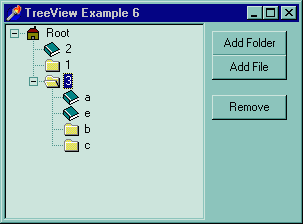
There are two ways to sort a tree. The first is extremely easy, just use the
TTreeView.AlphaSort method. The tree will, obviously enough, be sorted
alphabetically.
This type of simple sorting is more suitable for "simple" trees, like example 1 - 4. It is not good enough for more complex trees though.
Here is an example of an Alpha sorted tree

The problem here is that folder and file nodes are not grouped together. Optimally
the same tree, once sorted, should look like this

In this tree files are always displayed before folders. The more complex the tree
the more useful "grouping" becomes. TreeView's support user defined sorting, the
method to call is TTreeView.CustomSort.
The CustomSort function takes 2 parameters
| SortProc : TTVCompare | SortProc is a callback function. This function is called by the TTreeView and compares pairs of nodes. |
| Data : LongInt | You can pass any value to the callback function using this parameter.
If you want to pass a pointer then just type cast it to an integer. eg CustomSort( ..., integer(@Somthing) ); |
The callback function that is passed as param 1 is defined as follows
function( Node1, Node2 : TTreeNode; Data : integer ) : integer; stdcall;
What you have to do is compare Node1 and Node2, then return
| Positive integer | Node2 displayed before Node1 |
| 0 | Nodes are equivalent |
| Negative integer | Node1 displayed before Node2 |
The example callback function
/////////////////////////////////////
// Custom sort callback function
/////////////////////////////////////
function MyCustomSortProc( Node1, Node2 : TTreeNode; Data : integer ) : integer; stdcall;
{Inline function returns true if Node is a File}
function IsAFile( Node : TTreeNode ) : boolean;
begin
Result := ((Node.ImageIndex = IMG_NODE_FILE_CLOSED) or
(Node.ImageIndex = IMG_NODE_FILE_OPEN));
end;
{Inline function returns true if Node is a Folder}
function IsAFolder( Node : TTreeNode ) : boolean;
begin
Result := ((Node.ImageIndex = IMG_NODE_FOLDER_CLOSED) or
(Node.ImageIndex = IMG_NODE_FOLDER_OPEN));
end;
begin
{Files before folders}
if( IsAFile( Node1 ) and IsAFolder( Node2 ) ) then
begin
Result := -1;
Exit;
end;
{Folder after file}
if( IsAFolder( Node1 ) and IsAFile( Node2 ) ) then
begin
Result := 1;
Exit;
end;
{Nodes are of the same type, so do a normal alpha sort}
Result := AnsiStrIComp( PChar(Node1.Text), PChar(Node2.Text) );
end;
Calling the sort routine
tv_eg5.CustomSort( @MyCustomSortProc, 0 );
I've added the CustomSort call to the AddNode procedure. This means that every
time a node is added the tree is sorted. For this example that is exactly what must
happen. If you were loading a tree then you'd only want to sort it once the entire
load operation had been completed.
All information on these www pages is copyright (©) 1997 Andre .v.d. Merwe And may not be copied or mirrored without my permission.